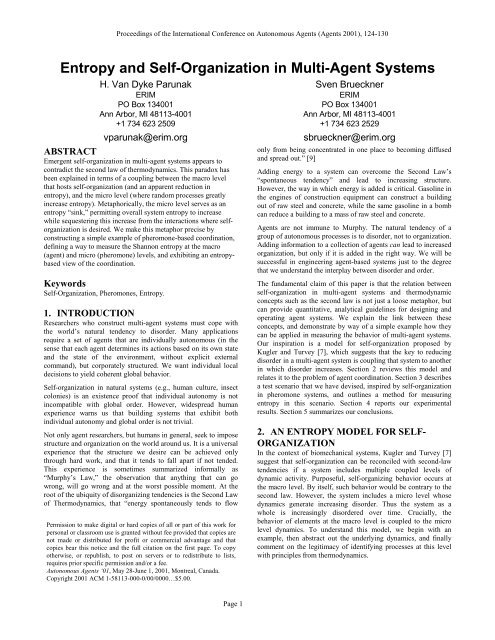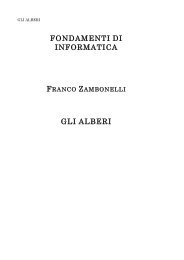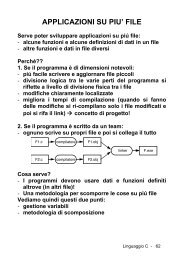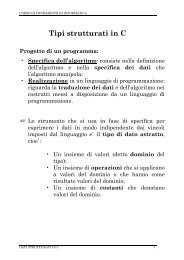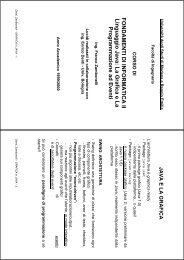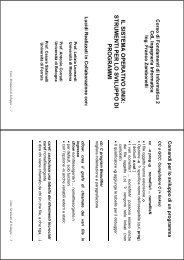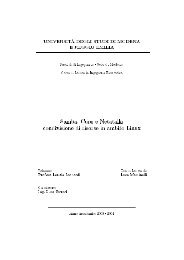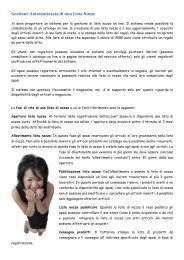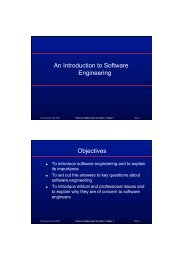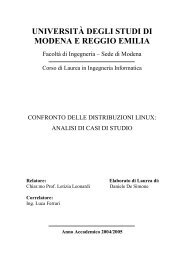Entropy and Self-Organization in Multi-Agent Systems - CiteSeerX
Entropy and Self-Organization in Multi-Agent Systems - CiteSeerX
Entropy and Self-Organization in Multi-Agent Systems - CiteSeerX
- No tags were found...
Create successful ePaper yourself
Turn your PDF publications into a flip-book with our unique Google optimized e-Paper software.
Proceed<strong>in</strong>gs of the International Conference on Autonomous <strong>Agent</strong>s (<strong>Agent</strong>s 2001), 124-130<strong>Entropy</strong> <strong>and</strong> <strong>Self</strong>-<strong>Organization</strong> <strong>in</strong> <strong>Multi</strong>-<strong>Agent</strong> <strong>Systems</strong>H. Van Dyke ParunakERIMPO Box 134001Ann Arbor, MI 48113-4001+1 734 623 2509vparunak@erim.orgABSTRACTEmergent self-organization <strong>in</strong> multi-agent systems appears tocontradict the second law of thermodynamics. This paradox hasbeen expla<strong>in</strong>ed <strong>in</strong> terms of a coupl<strong>in</strong>g between the macro levelthat hosts self-organization (<strong>and</strong> an apparent reduction <strong>in</strong>entropy), <strong>and</strong> the micro level (where r<strong>and</strong>om processes greatly<strong>in</strong>crease entropy). Metaphorically, the micro level serves as anentropy “s<strong>in</strong>k,” permitt<strong>in</strong>g overall system entropy to <strong>in</strong>creasewhile sequester<strong>in</strong>g this <strong>in</strong>crease from the <strong>in</strong>teractions where selforganizationis desired. We make this metaphor precise byconstruct<strong>in</strong>g a simple example of pheromone-based coord<strong>in</strong>ation,def<strong>in</strong><strong>in</strong>g a way to measure the Shannon entropy at the macro(agent) <strong>and</strong> micro (pheromone) levels, <strong>and</strong> exhibit<strong>in</strong>g an entropybasedview of the coord<strong>in</strong>ation.Keywords<strong>Self</strong>-<strong>Organization</strong>, Pheromones, <strong>Entropy</strong>.1. INTRODUCTIONResearchers who construct multi-agent systems must cope withthe world’s natural tendency to disorder. Many applicationsrequire a set of agents that are <strong>in</strong>dividually autonomous (<strong>in</strong> thesense that each agent determ<strong>in</strong>es its actions based on its own state<strong>and</strong> the state of the environment, without explicit externalcomm<strong>and</strong>), but corporately structured. We want <strong>in</strong>dividual localdecisions to yield coherent global behavior.<strong>Self</strong>-organization <strong>in</strong> natural systems (e.g., human culture, <strong>in</strong>sectcolonies) is an existence proof that <strong>in</strong>dividual autonomy is not<strong>in</strong>compatible with global order. However, widespread humanexperience warns us that build<strong>in</strong>g systems that exhibit both<strong>in</strong>dividual autonomy <strong>and</strong> global order is not trivial.Not only agent researchers, but humans <strong>in</strong> general, seek to imposestructure <strong>and</strong> organization on the world around us. It is a universalexperience that the structure we desire can be achieved onlythrough hard work, <strong>and</strong> that it tends to fall apart if not tended.This experience is sometimes summarized <strong>in</strong>formally as“Murphy’s Law,” the observation that anyth<strong>in</strong>g that can gowrong, will go wrong <strong>and</strong> at the worst possible moment. At theroot of the ubiquity of disorganiz<strong>in</strong>g tendencies is the Second Lawof Thermodynamics, that “energy spontaneously tends to flowPermission to make digital or hard copies of all or part of this work forpersonal or classroom use is granted without fee provided that copies arenot made or distributed for profit or commercial advantage <strong>and</strong> thatcopies bear this notice <strong>and</strong> the full citation on the first page. To copyotherwise, or republish, to post on servers or to redistribute to lists,requires prior specific permission <strong>and</strong>/or a fee.Autonomous <strong>Agent</strong>s ‘01, May 28-June 1, 2001, Montreal, Canada.Copyright 2001 ACM 1-58113-000-0/00/0000…$5.00.Sven BruecknerERIMPO Box 134001Ann Arbor, MI 48113-4001+1 734 623 2529sbrueckner@erim.orgonly from be<strong>in</strong>g concentrated <strong>in</strong> one place to becom<strong>in</strong>g diffused<strong>and</strong> spread out.” [9]Add<strong>in</strong>g energy to a system can overcome the Second Law’s“spontaneous tendency” <strong>and</strong> lead to <strong>in</strong>creas<strong>in</strong>g structure.However, the way <strong>in</strong> which energy is added is critical. Gasol<strong>in</strong>e <strong>in</strong>the eng<strong>in</strong>es of construction equipment can construct a build<strong>in</strong>gout of raw steel <strong>and</strong> concrete, while the same gasol<strong>in</strong>e <strong>in</strong> a bombcan reduce a build<strong>in</strong>g to a mass of raw steel <strong>and</strong> concrete.<strong>Agent</strong>s are not immune to Murphy. The natural tendency of agroup of autonomous processes is to disorder, not to organization.Add<strong>in</strong>g <strong>in</strong>formation to a collection of agents can lead to <strong>in</strong>creasedorganization, but only if it is added <strong>in</strong> the right way. We will besuccessful <strong>in</strong> eng<strong>in</strong>eer<strong>in</strong>g agent-based systems just to the degreethat we underst<strong>and</strong> the <strong>in</strong>terplay between disorder <strong>and</strong> order.The fundamental claim of this paper is that the relation betweenself-organization <strong>in</strong> multi-agent systems <strong>and</strong> thermodynamicconcepts such as the second law is not just a loose metaphor, butcan provide quantitative, analytical guidel<strong>in</strong>es for design<strong>in</strong>g <strong>and</strong>operat<strong>in</strong>g agent systems. We expla<strong>in</strong> the l<strong>in</strong>k between theseconcepts, <strong>and</strong> demonstrate by way of a simple example how theycan be applied <strong>in</strong> measur<strong>in</strong>g the behavior of multi-agent systems.Our <strong>in</strong>spiration is a model for self-organization proposed byKugler <strong>and</strong> Turvey [7], which suggests that the key to reduc<strong>in</strong>gdisorder <strong>in</strong> a multi-agent system is coupl<strong>in</strong>g that system to another<strong>in</strong> which disorder <strong>in</strong>creases. Section 2 reviews this model <strong>and</strong>relates it to the problem of agent coord<strong>in</strong>ation. Section 3 describesa test scenario that we have devised, <strong>in</strong>spired by self-organization<strong>in</strong> pheromone systems, <strong>and</strong> outl<strong>in</strong>es a method for measur<strong>in</strong>gentropy <strong>in</strong> this scenario. Section 4 reports our experimentalresults. Section 5 summarizes our conclusions.2. AN ENTROPY MODEL FOR SELF-ORGANIZATIONIn the context of biomechanical systems, Kugler <strong>and</strong> Turvey [7]suggest that self-organization can be reconciled with second-lawtendencies if a system <strong>in</strong>cludes multiple coupled levels ofdynamic activity. Purposeful, self-organiz<strong>in</strong>g behavior occurs atthe macro level. By itself, such behavior would be contrary to thesecond law. However, the system <strong>in</strong>cludes a micro level whosedynamics generate <strong>in</strong>creas<strong>in</strong>g disorder. Thus the system as awhole is <strong>in</strong>creas<strong>in</strong>gly disordered over time. Crucially, thebehavior of elements at the macro level is coupled to the microlevel dynamics. To underst<strong>and</strong> this model, we beg<strong>in</strong> with anexample, then abstract out the underly<strong>in</strong>g dynamics, <strong>and</strong> f<strong>in</strong>allycomment on the legitimacy of identify<strong>in</strong>g processes at this levelwith pr<strong>in</strong>ciples from thermodynamics.Page 1
Parunak <strong>and</strong> Brueckner, <strong>Entropy</strong> <strong>and</strong> <strong>Self</strong>-<strong>Organization</strong> <strong>in</strong> <strong>Multi</strong>-<strong>Agent</strong> <strong>Systems</strong>2.1 An Example: PheromonesThe parade example of such a system is the self-organization of an<strong>in</strong>sect colony (such as the construction of m<strong>in</strong>imal spann<strong>in</strong>g treenetworks among nests <strong>and</strong> food sources by ants, or the erection ofmulti-storied structures with regularly spaced pillars <strong>and</strong> floors bytropical termites), through pheromone-based coord<strong>in</strong>ation [1, 11].Pheromones are scent markers that <strong>in</strong>sects use <strong>in</strong> two ways. First,they deposit pheromones <strong>in</strong> the environment to record their state.For example, a forag<strong>in</strong>g ant just emerg<strong>in</strong>g from the nest <strong>in</strong> searchof food might deposit nest pheromone, while an ant that has foundfood <strong>and</strong> is carry<strong>in</strong>g it will deposit food pheromone. ([15]documents use of multiple pheromones by <strong>in</strong>sects.) Second, theyorient their movements to the gradient of the pheromone field. Inthe example of forag<strong>in</strong>g ants, those seek<strong>in</strong>g food climb thegradient of the food pheromone, while those carry<strong>in</strong>g food climbthe gradient of the nest pheromone. The most realistic models ofthe ants’ pheromone-climb<strong>in</strong>g behavior <strong>in</strong>corporates a stochasticelement <strong>in</strong> their movement. That is, they do not follow thegradient determ<strong>in</strong>istically, but use its strength to weight a roulettewheel from which they determ<strong>in</strong>e their movement.The environment <strong>in</strong> which pheromones are deposited plays acritical role <strong>in</strong> such a system. It is not passive, but active, <strong>and</strong>performs three <strong>in</strong>formation-process<strong>in</strong>g functions with thepheromones.1. It aggregates deposits of the same flavor of pheromone fromdifferent ants, thus provid<strong>in</strong>g a form of data fusion acrossmultiple agents at different times, based on their traversal ofa common location.2. It evaporates pheromones over time, thus forgett<strong>in</strong>g obsolete<strong>in</strong>formation. This dynamic is usefully viewed as a novelapproach to truth ma<strong>in</strong>tenance. Conventional knowledgebases remember every assertion unless there is cause toretract it, <strong>and</strong> execute truth ma<strong>in</strong>tenance processes to detect<strong>and</strong> resolve the conflicts that result when <strong>in</strong>consistentassertions coexist. Insect systems forget every assertionunless it is regularly re<strong>in</strong>forced.3. Evaporation provides a third function, that of dissem<strong>in</strong>at<strong>in</strong>g<strong>in</strong>formation from the location at which it was deposited tonearby locations. An ant does not have to stumble across theexact location at which pheromone was deposited <strong>in</strong> order toaccess the <strong>in</strong>formation it represents, but can sense thedirection from its current location to the pheromone deposit<strong>in</strong> the form of the gradient of evaporated pheromonemolecules.2.2 The Model <strong>in</strong> DetailIn the Kugler-Turvey model, ants <strong>and</strong> their movements constitutethe macro level of the system, while pheromone moleculesconstitute the micro level. The purposeful movement of ants,construct<strong>in</strong>g m<strong>in</strong>imal paths among their nests <strong>and</strong> food sources,achieve a reduction <strong>in</strong> disorder at the macro level, made possiblebecause the agents at this level are coupled to the micro level,where the evaporation of pheromone molecules under Brownianmotion results <strong>in</strong> an overwhelm<strong>in</strong>g growth <strong>in</strong> disorder. As a result,the disorder of the overall system <strong>in</strong>creases, <strong>in</strong> keep<strong>in</strong>g with theSecond Law, <strong>in</strong> spite of the emergence of useful order at themacro level.MacroNon-NewtonianFlow Field“Negentropy”MicroNewtonian;Force Field;<strong>Entropy</strong>Figure 1 illustrates the <strong>in</strong>terplay among these processes, <strong>and</strong> howthis model of agent coord<strong>in</strong>ation differs from more classicalviews. Classically, agents are considered to perceive one anotherdirectly, reason about this perception, <strong>and</strong> then take rationalaction. The Kugler-Turvey model views coord<strong>in</strong>ation as be<strong>in</strong>gmediated by an environment that agents change by their actions(e.g., deposit<strong>in</strong>g pheromones), a process known as “stigmergy”[4]. Processes <strong>in</strong> the environment generate structures that theagents perceive, thus permitt<strong>in</strong>g ordered behavior at the agentlevel. At the same time, these processes <strong>in</strong>crease disorder at themicro level, so that the system as a whole becomes less orderedover time.Research <strong>in</strong> synthetic pheromones [2, 12, 13] draws directly onthis model of coord<strong>in</strong>ation, but the model is of far broaderapplicability. In a multi-commodity market, <strong>in</strong>dividual agentsfollow economic fields generated by myriad <strong>in</strong>dividualtransactions, <strong>and</strong> self-organization <strong>in</strong> the dem<strong>and</strong> <strong>and</strong> supply of aparticular commodity is supported by an environment thatdistributes resources based on the other transactions <strong>in</strong> the system.The movement of currency <strong>in</strong> such a system provides similarfunctions to those of pheromones <strong>in</strong> <strong>in</strong>sect systems. More broadly,we hypothesize that a coupl<strong>in</strong>g of ordered <strong>and</strong> disordered systemsis ubiquitous <strong>in</strong> robust self-organiz<strong>in</strong>g systems, <strong>and</strong> that the lackof such a coupl<strong>in</strong>g correlates with architectures that do not meettheir designers’ expectations for emergent cohesiveness.2.3 A CaveatAt this po<strong>in</strong>t, readers with a background <strong>in</strong> physics <strong>and</strong> chemistrymay be uneasy. These discipl<strong>in</strong>es formulated the Second Lawwith<strong>in</strong> a strict context of processes that result <strong>in</strong> energy changes.The fundamental physical measures associated with the secondlaw are temperature T, heat Q, <strong>and</strong> (thermodynamic) entropy S,related by the def<strong>in</strong>itionEquation 1dQdS =TStatistical mechanics identifies this macroscopic measure with thenumber Ω of microscopically def<strong>in</strong>ed states accessible to thesystem by the relationEquation 2PerceptionKeyTraditional <strong>Agent</strong>Dynamics<strong>Agent</strong> 1 Perception<strong>Agent</strong> 2Rational ActionRational Action(<strong>Entropy</strong> )pFlow(<strong>Entropy</strong> n )PheromoneDynamicsPheromoneS ≡ k ln Ωwhere k is Boltzmann’s constant, 1.4E-16 erg/deg.pRational Action(<strong>Entropy</strong> )Flow(<strong>Entropy</strong> n )Figure 1. Comparison of Conventional <strong>and</strong> Pheromone-BasedModels of Coord<strong>in</strong>ationPerceptionPage 2
Parunak <strong>and</strong> Brueckner, <strong>Entropy</strong> <strong>and</strong> <strong>Self</strong>-<strong>Organization</strong> <strong>in</strong> <strong>Multi</strong>-<strong>Agent</strong> <strong>Systems</strong>Thus def<strong>in</strong>ed, thermodynamic entropy has strong formalsimilarities [10] to <strong>in</strong>formation entropy [14]Equation 3S = − p ilog p i∑iwhere i ranges over the possible states of the system <strong>and</strong> p i is theprobability of f<strong>in</strong>d<strong>in</strong>g the system <strong>in</strong> state i. These formalsimilarities have led to a widespread appropriation of the notionof “entropy” as a measure of macro-level disorder, <strong>and</strong> of theSecond Law as describ<strong>in</strong>g a tendency of systems to become morechaotic. Our approach participates to this appropriation.It has been objected [8] that such appropriation completelyignores the role of energy <strong>in</strong>tr<strong>in</strong>sic to both thermodynamicdef<strong>in</strong>itions (via T <strong>and</strong> dQ <strong>in</strong> the macro def<strong>in</strong>ition <strong>and</strong> k <strong>in</strong> themicro def<strong>in</strong>ition). Such an objection implicitly assumes thatenergy is logically prior to the def<strong>in</strong>ition, <strong>and</strong> that unless<strong>in</strong>formation processes are def<strong>in</strong>ed <strong>in</strong> terms of energy changes, it isillegitimate to identify their changes <strong>in</strong> entropy with those ofthermodynamics. An alternative approach to the question wouldargue that <strong>in</strong> fact the prior concept is not ergs but bits, theuniverse is noth<strong>in</strong>g but a very large cellular automaton with verysmall cells [3, 6], <strong>and</strong> physics <strong>and</strong> chemistry can <strong>in</strong> pr<strong>in</strong>ciple beredef<strong>in</strong>ed <strong>in</strong> terms of <strong>in</strong>formation-theoretic concepts. Ourapproach is sympathetic with this view. While we are not preparedat this po<strong>in</strong>t to def<strong>in</strong>e the precise correspondence between ergs<strong>and</strong> bits, we believe that physical models are an under-exploitedresource for underst<strong>and</strong><strong>in</strong>g computational systems <strong>in</strong> general <strong>and</strong>multi-agent systems <strong>in</strong> particular. The fact that the thermodynamic<strong>and</strong> <strong>in</strong>formation approaches work <strong>in</strong> different fundamental units(ergs vs. bits) is not a reason to separate them, but a pole star toguide research that may ultimately br<strong>in</strong>g them together.3. EXPERIMENTAL SETUPWe experiment with these concepts us<strong>in</strong>g a simple model ofpheromone-based behavior. In this section we describe theexperiment <strong>and</strong> how one measures entropy over it.3.1 The Coord<strong>in</strong>ation ProblemConsider two agents, one fixed <strong>and</strong> one mobile, who desire to betogether. Neither knows the location of the other. The mobileagent, or walker, could travel to the dest<strong>in</strong>ation of the stationaryone, if it only knew where to go. The stationary agent, or target,deposits pheromone molecules at its location. As the pheromonemolecules diffuse through the environment, they create a gradientthat the walker can follow.Initially, the walker is at (30,30) <strong>and</strong> the target is at (50,50) <strong>in</strong> a100x100 field. Every time step, the target deposits one moleculeat (50,50). Both the walker <strong>and</strong> the pheromone molecules moveby comput<strong>in</strong>g an angle θ ∈ [0,2π] relative to their current head<strong>in</strong>g<strong>and</strong> tak<strong>in</strong>g a step of constant length (1 for the walker, 2 for thepheromone molecule) <strong>in</strong> the result<strong>in</strong>g direction. Thus bothmolecules <strong>and</strong> walkers can be located at any real-valuedcoord<strong>in</strong>ates <strong>in</strong> the field. Molecules move every cycle of thesimulation <strong>and</strong> the walker every five cycles, so altogether themolecules move ten times as fast as the walker. Molecules fall offof the field when they reach the edge, while the walker bouncesoff the edges.Molecules choose the head<strong>in</strong>g for their next step from a uniformr<strong>and</strong>om distribution, <strong>and</strong> so execute an unbiased r<strong>and</strong>om walk.The walker computes its head<strong>in</strong>g from two <strong>in</strong>puts.1. It generates a gradient vector G & from its current location toeach molecule with<strong>in</strong> a specified radius ρ, with magnitude& gEquation 4 G = ∑ 2rr < ρ iiwhere r i is the distance between the walker <strong>and</strong> the ithmolecule <strong>and</strong> g is a “gravitational constant” (currently 1).2. It generates a r<strong>and</strong>om vector R & with r<strong>and</strong>om head<strong>in</strong>g <strong>and</strong>length equal to a temperature parameter T.The vector sum G& + R&, normalized to the walker’s step length(1 <strong>in</strong> these experiments), def<strong>in</strong>es the walker’s next step. Includ<strong>in</strong>gR & <strong>in</strong> the computation permits us to explore the effectiveness ofdifferent degrees of stochasticity <strong>in</strong> the walker’s movement,follow<strong>in</strong>g the example of natural pheromone systems.The state of the walker def<strong>in</strong>es the macro state of the system,while the states of the molecules def<strong>in</strong>e the micro state. Thismodel can easily be enhanced <strong>in</strong> a number of directions, <strong>in</strong>clud<strong>in</strong>gadd<strong>in</strong>g multiple walkers <strong>and</strong> multiple targets, <strong>and</strong> permitt<strong>in</strong>gwalkers <strong>and</strong> targets to deposit pheromone molecules of variousflavors. The simple configuration is sufficient to demonstrate ourtechniques <strong>and</strong> their potential for underst<strong>and</strong><strong>in</strong>g how the walkerf<strong>in</strong>ds the target.3.2 Measur<strong>in</strong>g <strong>Entropy</strong>Comput<strong>in</strong>g the Shannon or Information <strong>Entropy</strong> def<strong>in</strong>ed <strong>in</strong>Equation 3 requires that we measure1. the set of states accessible to the system <strong>and</strong>2. the probability of f<strong>in</strong>d<strong>in</strong>g the system <strong>in</strong> each of those states.3.2.1 Measur<strong>in</strong>g the Number of System StatesIn most computational systems, the discreteness of digitalcomputation makes count<strong>in</strong>g system states straightforward(though the number of possible states is extremely high). We havepurposely def<strong>in</strong>ed the movement of our walker <strong>and</strong> molecules <strong>in</strong>cont<strong>in</strong>uous space to highlight the challenge of count<strong>in</strong>g discretesystem states <strong>in</strong> an application embedded <strong>in</strong> the physical world(such as a robotic application). Our approach is to superimpose agrid on the field, <strong>and</strong> def<strong>in</strong>e a state on the basis of the populationsof the cells of the grid.We can def<strong>in</strong>e state, <strong>and</strong> thus entropy, <strong>in</strong> terms either of locationor direction. Location-based state is based on a s<strong>in</strong>gle snapshot ofthe system, while direction-based state is based on how the systemhas changed between successive snapshots. Each approach has anassociated gridd<strong>in</strong>g technique.For location-based entropy, we divide the field with a grid. Figure2 shows a 2x2 grid with four cells, one spann<strong>in</strong>g each quarter ofthe field. The state of this system is a four-element vectorreport<strong>in</strong>g the number of molecules <strong>in</strong> each cell (<strong>in</strong> the example,read<strong>in</strong>g row-wise from upper left, . The number ofpossible states <strong>in</strong> an nxn grid with m particles is n 2m . Theparameters <strong>in</strong> location-based gridd<strong>in</strong>g are the number of divisions<strong>in</strong> each direction, their orientation, <strong>and</strong> the orig<strong>in</strong> of the grid.Page 3
Parunak <strong>and</strong> Brueckner, <strong>Entropy</strong> <strong>and</strong> <strong>Self</strong>-<strong>Organization</strong> <strong>in</strong> <strong>Multi</strong>-<strong>Agent</strong> <strong>Systems</strong>(0,0) (100,0)(0,100) (100,100)Figure 2. Location-based gridd<strong>in</strong>g.Rectangular grids are easiest to manage computationally, but onecould also tile the plane with hexagons.For direction-based entropy, we center a star on the previouslocation of each particle <strong>and</strong> record the sector of the star <strong>in</strong>towhich the particle is found at the current step. Figure 3 shows afour-rayed star with a two particles. The state of the system is avector with one element for each particle <strong>in</strong> some canonical order.Count<strong>in</strong>g sectors clockwise from the upper left, the state of thisexample is . The number of possible states with an n-po<strong>in</strong>ted star <strong>and</strong> m particles is mn. The parameters <strong>in</strong> directionbasedgridd<strong>in</strong>g are the number of rays <strong>in</strong> the star <strong>and</strong> the rotationof the star about its center.In both techniques, the analysis depends critically on theresolution of the grid (the parameter n) <strong>and</strong> its orig<strong>in</strong> <strong>and</strong>orientation (for location) or rotation (for direction).To underst<strong>and</strong> the dependency on n, consider two extremes. If n isvery large, the chance of two distributions of particles on the fieldhav<strong>in</strong>g the same state is vanish<strong>in</strong>gly small. For N distributions,(0,0) (100,0)2each will be a dist<strong>in</strong>ct state, each state will have equal probability1/N, <strong>and</strong> the entropy will be log(N). This state of affairs is clearlynot <strong>in</strong>formative. At the other extreme, n = 1, all distributionsrepresent the same state, which therefore occurs with probability1, yield<strong>in</strong>g entropy 0, aga<strong>in</strong> not <strong>in</strong>formative. We choose thegridd<strong>in</strong>g resolution empirically by observ<strong>in</strong>g the length scalesactive <strong>in</strong> the system as it operates.To underst<strong>and</strong> the dependency on orig<strong>in</strong>/orientation or rotation,consider two particles <strong>in</strong> the same cell. After they move, will theystill be <strong>in</strong> the same cell (keep<strong>in</strong>g entropy the same) or <strong>in</strong> differentcells (<strong>in</strong>creas<strong>in</strong>g entropy)? Exactly the same movements of thetwo particles could yield either result, depend<strong>in</strong>g on how the gridis registered with the field. We follow Gutowitz’s technique [5] ofmeasur<strong>in</strong>g the entropy with several different orig<strong>in</strong>s <strong>and</strong> tak<strong>in</strong>g them<strong>in</strong>imum, thus m<strong>in</strong>imiz<strong>in</strong>g entropy contributions result<strong>in</strong>g fromthe discrete nature of the grid.3.2.2 Measur<strong>in</strong>g the ProbabilitiesIn pr<strong>in</strong>ciple, one could compute the probability of differentsystem states analytically. This approach would be arduous evenfor our simple system, <strong>and</strong> completely impractical for a morecomplex system. We take a Monte Carlo approach <strong>in</strong>stead. Werun the system repeatedly. At each step <strong>in</strong> time, we estimate theprobability of each observed state by count<strong>in</strong>g the number ofreplications <strong>in</strong> which that state was observed. The results reportedhere are based on 30 replications.Shannon entropy has a maximum value of log(N) for N differentstates, achieved when each state is equally probable. To elim<strong>in</strong>atethis dependence on N, we normalize the entropies we report bydivid<strong>in</strong>g by log(N) (<strong>in</strong> our case, log(30)), <strong>in</strong>cidentally mak<strong>in</strong>g thechoice of base of logarithms irrelevant.4. EXPERIMENTAL RESULTSWe report the behavior of entropy first <strong>in</strong> the micro system, then<strong>in</strong> the unguided <strong>and</strong> guided macro system, <strong>and</strong> f<strong>in</strong>ally <strong>in</strong> thecomplete system.4.1 <strong>Entropy</strong> <strong>in</strong> the Micro SystemFigure 4 shows locational entropy <strong>in</strong> the micro system (thepheromone molecules), computed from a 5x5 grid. <strong>Entropy</strong><strong>in</strong>creases with time until it saturates at 1. The more moleculesenter the system <strong>and</strong> the more they disperse throughout the field,the higher the entropy grows. Increas<strong>in</strong>g the grid resolution has noeffect on the shape of this <strong>in</strong>crease, but reduces the time tosaturation, because the molecules must spread out from a s<strong>in</strong>gle11MicroEntrop y0.80.60.40.2(0,100) (100,100)Figure 3. Direction-based gridd<strong>in</strong>g.0 50 100 150 200 250TimeFigure 4. Micro <strong>Entropy</strong> x Time (5x5 Grid)Page 4
Parunak <strong>and</strong> Brueckner, <strong>Entropy</strong> <strong>and</strong> <strong>Self</strong>-<strong>Organization</strong> <strong>in</strong> <strong>Multi</strong>-<strong>Agent</strong> <strong>Systems</strong>y555045403530y55504540353030 35 40 45 50 55xFigure 5. Unguided Walker Path. Axes are location <strong>in</strong> the(100x100) field.location <strong>and</strong> the f<strong>in</strong>er the grid, the sooner they can generate alarge number of different states.Directional entropy also <strong>in</strong>creases with time to saturation. Thisresult (not plotted) can be derived analytically. The moleculepopulation <strong>in</strong>creases l<strong>in</strong>early with time until molecules startreach<strong>in</strong>g the edge. Then the growth slows, <strong>and</strong> eventually reaches0. Let M be the population of the field at equilibrium, <strong>and</strong>consider all M molecules be<strong>in</strong>g located at (50,50) through theentire run. Initially, all are stationary, <strong>and</strong> each time step oneadditional molecule is activated. Then the total number ofpossible system states for a 4-star is 4M, but the number actuallysampled dur<strong>in</strong>g the period of l<strong>in</strong>ear population growth is 4t, s<strong>in</strong>cethe stationary molecules do not generate any additional states.Thus the entropy dur<strong>in</strong>g the l<strong>in</strong>ear phase is log(4t)/log(4M). Asthe growth becomes subl<strong>in</strong>ear, the entropy asymptoticallyapproaches 1, as with locational entropy.4.2 <strong>Entropy</strong> <strong>in</strong> the Unguided Macro SystemFigure 5 shows the path of a walker uncoupled to the microsystem (when the target is emitt<strong>in</strong>g no pheromone molecules).With no coupl<strong>in</strong>g to the micro field, the walker is just a s<strong>in</strong>glemolecule execut<strong>in</strong>g a r<strong>and</strong>om walk. Figure 6 shows that locationalentropy for this walker <strong>in</strong>creases over time, reflect<strong>in</strong>g the<strong>in</strong>creased number of cells accessible to the walker as its r<strong>and</strong>omwalk takes it farther from its base. The grid size (15 divisions <strong>in</strong>each direction) is chosen on the basis of observations of theguided walker, discussed <strong>in</strong> the next section.The directional entropy (not plotted) is constant at 1, s<strong>in</strong>ce thewalker chooses r<strong>and</strong>omly at each step from all availableMacroEntrop y10.80.60.40.2directions.30 35 40 45 50 55x4.3 <strong>Entropy</strong> <strong>in</strong> Guided Macro SystemNow we provide the walker with a micro field by emitt<strong>in</strong>gpheromone molecules from the target. Figure 7 shows the pathfollowed by a typical walker with radius ρ = 20 <strong>and</strong> T = 0. Thispath has three dist<strong>in</strong>ct parts.• Initially, the walker w<strong>and</strong>ers r<strong>and</strong>omly around its orig<strong>in</strong> at(30,30), until the wavefront of molecules diffus<strong>in</strong>g from(50,50) encounters its radius. In this region, the walker hasno guidance, because no molecules are visible.• Once the walker beg<strong>in</strong>s to sense molecules, it moves ratherdirectly from the vic<strong>in</strong>ity of (30,30) to (50,50), follow<strong>in</strong>g thepheromone gradient.• When it arrives at (50,50), it aga<strong>in</strong> receives no guidance fromthe molecules, because they are distributed equally <strong>in</strong> alldirections. So it aga<strong>in</strong> me<strong>and</strong>ers.The clouds of w<strong>and</strong>er<strong>in</strong>g near the start <strong>and</strong> f<strong>in</strong>ish have diameters<strong>in</strong> the range of 5 to 10, suggest<strong>in</strong>g a natural grid between 20x20<strong>and</strong> 10x10. We report here experiments with a 15x15 grid.Because of their <strong>in</strong>itial r<strong>and</strong>om walk around their orig<strong>in</strong>, walkers<strong>in</strong> different runs will be at different locations when they start tomove, <strong>and</strong> will follow slightly different paths to the target (Figure8).The dots <strong>in</strong> Figure 9 <strong>and</strong> Figure 10 show the directional <strong>and</strong>locational entropies across this ensemble of guided walkers as afunction of time. The solid l<strong>in</strong>e <strong>in</strong> each case plots the normalizedmedian distance from the walkers to the target (actual maximumy555045403530Figure 7. Guided Walker Path (U = 20, T = 0)0 50 100 150 200 250TimeFigure 6. Unguided Walker Locational <strong>Entropy</strong> (15x15 Grid)30 35 40 45 50 55xFigure 8. Ensemble of Guided Walkers (U = 20, T = 0)Page 5
Parunak <strong>and</strong> Brueckner, <strong>Entropy</strong> <strong>and</strong> <strong>Self</strong>-<strong>Organization</strong> <strong>in</strong> <strong>Multi</strong>-<strong>Agent</strong> <strong>Systems</strong><strong>Entropy</strong>10.80.60.40.20 10 20 30 40 50TimeDistance<strong>and</strong> Molecule sFigure 9. Guided walker: dots = directional entropy (4 star),solid l<strong>in</strong>e = median distance to target (max 28), dashed l<strong>in</strong>e =median visible molecules (max 151).28), while the dashed l<strong>in</strong>e plots the normalized median number ofmolecules visible to the walkers (actual maximum 151). The l<strong>in</strong>esshow how changes <strong>in</strong> entropy <strong>and</strong> reduction <strong>in</strong> distance to thetarget are correlated with the number of molecules that the walkersenses at any given moment.At the beg<strong>in</strong>n<strong>in</strong>g <strong>and</strong> end of the run, when the walkers arew<strong>and</strong>er<strong>in</strong>g without guidance, directional entropy is 1,correspond<strong>in</strong>g to a r<strong>and</strong>om walk. Dur<strong>in</strong>g the middle portion of therun, when the walker is receiv<strong>in</strong>g useful guidance from the microlevel, the entropy drops dramatically. As the temperatureparameter T is <strong>in</strong>creased <strong>in</strong> the range 50 to 100, the bottom of theentropy well rises, but the overall shape rema<strong>in</strong>s the same (plotnot shown).The locational entropy presents a different story. Them<strong>in</strong>imization method for avoid<strong>in</strong>g discreteness artifacts has theeffect of select<strong>in</strong>g at each time step the offset that best centers thecells on the walkers. At the beg<strong>in</strong>n<strong>in</strong>g of the run <strong>and</strong> aga<strong>in</strong> at theend, most walkers are close together, <strong>and</strong> fall with<strong>in</strong> the same cell(because we chose a cell size comparable to these clouds).Walkers leave the start<strong>in</strong>g cloud at different times, s<strong>in</strong>ce thosecloser to the target sense the pheromones sooner, <strong>and</strong> followdifferent paths, depend<strong>in</strong>g on where they were when thepheromone reached them. Thus they spread out dur<strong>in</strong>g thismovement phase, <strong>and</strong> cluster together aga<strong>in</strong> once they reach thetarget. The effect of rais<strong>in</strong>g T to 100 on locational entropy is thatthe right end of the curve rises until the curve assumes a similarMacroEntrop y10.80.60.40.20 50 100 150 200 250TimeDistance<strong>and</strong> Molecule sFigure 10. Guided walker: dots = locational entropy (15x15grid), solid l<strong>in</strong>e = median distance to target (max 28), dashedl<strong>in</strong>e = median visible molecules (max 151).shape (plot not shown) to Figure 6.Comparison of Figure 6 <strong>and</strong> Figure 10 shows that though thedirected portion of the walker’s movement has higher entropythan the undirected portions, coupl<strong>in</strong>g the walker to the microlevel does reduce the walker’s overall entropy. Even at itsmaximum, the entropy of the guided walker is much lower thanthat of the r<strong>and</strong>om one, demonstrat<strong>in</strong>g the basic dynamics of theKugler-Turvey model.The different behavior of locational <strong>and</strong> directional entropy is<strong>in</strong>structive. Which is more orderly: a r<strong>and</strong>omly mov<strong>in</strong>g walker, orone guided by pheromones? The expected location of a r<strong>and</strong>omwalker is stationary (though with a non-zero variance), while thatof a guided walker is non-stationary. In terms of location, ther<strong>and</strong>om walker is thus more regular, <strong>and</strong> the location entropyreflects this. However, the movement of the guided walker is moreorderly than that of the r<strong>and</strong>om walker, <strong>and</strong> this difference isreflected <strong>in</strong> the directional entropy. This difference highlights theimportance of pay<strong>in</strong>g attention to dynamical aspects of agentbehavior. Our <strong>in</strong>tuition that the guided walker is more orderlythan the r<strong>and</strong>om one is really an <strong>in</strong>tuition about the movement ofthis walker, not its location.4.4 <strong>Entropy</strong> <strong>in</strong> the Overall SystemCentral to the Kugler-Turvey model is the assertion that entropy<strong>in</strong>crease at the micro level is sufficient to ensure entropy <strong>in</strong>crease<strong>in</strong> the overall system even <strong>in</strong> the presence of self-organization <strong>and</strong>concomitant entropy reduction at the micro level. Our experimentillustrates this dynamic. As illustrated <strong>in</strong> Figure 4, by time 60,normalized entropy <strong>in</strong> the micro system has reached the maximumlevel of 1, <strong>in</strong>dicat<strong>in</strong>g that each of the 30 replications of theexperiment results <strong>in</strong> a dist<strong>in</strong>ct state. If each replication is alreadydist<strong>in</strong>ct on the basis of the locations of the pheromone moleculesalone, add<strong>in</strong>g additional state elements (such as the location of thewalker) cannot cause two replications to become the same. Thusby time 60 the normalized entropy of the entire system must alsobe at a maximum. In particular, decreases <strong>in</strong> macro entropy, suchas the decrease <strong>in</strong> locational entropy from time 80 on seen <strong>in</strong>Figure 10, do not reduce the entropy of the overall system.One may ask whether the reduction <strong>in</strong> macro (walker) entropy iscausally related to the <strong>in</strong>crease <strong>in</strong> micro entropy, or justco<strong>in</strong>cidental. After all, a static gradient of pheromone moleculeswould guide the walker to the target just as effectively, but wouldbe identical <strong>in</strong> every run, <strong>and</strong> so exhibit zero entropy. Thisargument neglects whatever process generates the static gradient<strong>in</strong> the first place. An <strong>in</strong>telligent observer could produce thegradient, but then the behavior of the system would hardly be“self-organiz<strong>in</strong>g.” In our scenario, the gradient emerges as anatural consequence of a completely r<strong>and</strong>om process, the r<strong>and</strong>omwalk of the pheromone molecules emerg<strong>in</strong>g from the target. Thegradient can then reduce the entropy of a walker at the macrolevel, but the price paid for this entropy reduction is the <strong>in</strong>crease<strong>in</strong> entropy generated by the r<strong>and</strong>om process that produces <strong>and</strong>ma<strong>in</strong>ta<strong>in</strong>s the gradient.One may also ask whether our hypothesis requires a quantitativerelation between entropy loss at the macro level <strong>and</strong> entropy ga<strong>in</strong>at the micro level. A strict entropy balance is not required; themicro level might generate more entropy than the macro levelloses. In operational terms, the system may have a greater capacityfor coord<strong>in</strong>ation than a particular <strong>in</strong>stantiation exploits. What isPage 6
Parunak <strong>and</strong> Brueckner, <strong>Entropy</strong> <strong>and</strong> <strong>Self</strong>-<strong>Organization</strong> <strong>in</strong> <strong>Multi</strong>-<strong>Agent</strong> <strong>Systems</strong>required is that the entropy <strong>in</strong>crease at the micro level besufficient to cover the decrease at the macro level, <strong>and</strong> this wehave shown.5. SUMMARYTo be effective, multi-agent systems must yield coord<strong>in</strong>atedbehavior from <strong>in</strong>dividually autonomous actions. Concepts fromthermodynamics (<strong>in</strong> particular, the Second Law <strong>and</strong> entropy) havebeen <strong>in</strong>voked metaphorically to expla<strong>in</strong> the conditions underwhich coord<strong>in</strong>ation can emerge. Our work makes this metaphormore concrete <strong>and</strong> derives several important <strong>in</strong>sights from it.• This metaphor can be made quantitative, through simple statepartition<strong>in</strong>g methods <strong>and</strong> Monte Carlo simulation.• These methods show how coord<strong>in</strong>ation can arise throughcoupl<strong>in</strong>g the macro level (<strong>in</strong> which we desire agent selforganizationwith a concomitant decrease <strong>in</strong> entropy) to anentropy-<strong>in</strong>creas<strong>in</strong>g process at a micro level (e.g., pheromoneevaporation). Our demonstration focuses on syntheticpheromones for the sake of expositional simplicity, but webelieve that the same approach would be fruitful forunderst<strong>and</strong><strong>in</strong>g self-organization with other mechanisms ofagent coord<strong>in</strong>ation, such as market systems.• This confirmation of the Kugler-Turvey model encourages usas agent designers to th<strong>in</strong>k explicitly <strong>in</strong> terms of macro <strong>and</strong>micro levels, with agent behaviors at the macro level coupled<strong>in</strong> both directions (causally <strong>and</strong> perceptually) to entropy<strong>in</strong>creas<strong>in</strong>gprocesses at the micro level.• Some form of pheromone or currency is a convenientmechanism for creat<strong>in</strong>g such an entropy-<strong>in</strong>creas<strong>in</strong>g process.• Researchers must dist<strong>in</strong>guish between static <strong>and</strong> dynamicorder <strong>in</strong> a multi-agent system. We have exhibited a systemthat appears <strong>in</strong>tuitively to be self-organiz<strong>in</strong>g, <strong>and</strong> shown thatthe measure of order underly<strong>in</strong>g this <strong>in</strong>tuition is dynamicrather than static.6. ACKNOWLEDGMENTSThis work is supported <strong>in</strong> part by the DARPA JFACC programunder contract F30602-99-C-0202 to ERIM CEC. The views <strong>and</strong>conclusions <strong>in</strong> this document are those of the authors <strong>and</strong> shouldnot be <strong>in</strong>terpreted as represent<strong>in</strong>g the official policies, eitherexpressed or implied, of the Defense Advanced Research ProjectsAgency or the US Government.7. REFERENCES[1] E. Bonabeau, M. Dorigo, <strong>and</strong> G. Theraulaz. SwarmIntelligence: From Natural to Artificial <strong>Systems</strong>. New York,Oxford University Press, 1999.[2] S. Brueckner. Return from the Ant: Synthetic Ecosystems forManufactur<strong>in</strong>g Control. Thesis at Humboldt UniversityBerl<strong>in</strong>, Department of Computer Science, 2000.[3] E. Fredk<strong>in</strong>. F<strong>in</strong>ite Nature. In Proceed<strong>in</strong>gs of The XXVIIthRecontre de Moriond, 1992.[4] P.-P. Grassé. La Reconstruction du nid et les Coord<strong>in</strong>ationsInter-Individuelles chez Bellicositermes Natalensis etCubitermes sp. La théorie de la Stigmergie: Essaid'<strong>in</strong>terprétation du Comportement des Termites Constructeurs.Insectes Sociaux, 6:41-80, 1959.[5] H. A. Gutowitz. Complexity-Seek<strong>in</strong>g Ants. In Proceed<strong>in</strong>gs ofThird European Conference on Artifical Life, 1993.[6] B. Hayes. Computational Creationism. American Scientist,87(5):392-396, 1999.[7] P. N. Kugler <strong>and</strong> M. T. Turvey. Information, Natural Law,<strong>and</strong> the <strong>Self</strong>-Assembly of Rhythmic Movement. LawrenceErlbaum, 1987.[8] F. L. Lambert. Shuffled Cards, Messy Desks, <strong>and</strong> DisorderlyDorm Rooms - Examples of <strong>Entropy</strong> Increase? Nonsense!Journal of Chemical Education, 76:1385, 1999.[9] F. L. Lambert. The Second Law of Thermodynamics. 2000.Web Page, http://www.secondlaw.com/.[10] J. Lukkar<strong>in</strong>en. Re: cont<strong>in</strong>u<strong>in</strong>g on <strong>Entropy</strong>. 2000. EmailArchive,http://necsi.org:8100/Lists/complexscience/Message/2236.html.[11] H. V. D. Parunak. ’Go to the Ant’: Eng<strong>in</strong>eer<strong>in</strong>gPr<strong>in</strong>ciples from Natural <strong>Agent</strong> <strong>Systems</strong>. Annals of OperationsResearch, 75:69-101, 1997.[12] H. V. D. Parunak <strong>and</strong> S. Brueckner. Ant-LikeMissionaries <strong>and</strong> Cannibals: Synthetic Pheromones forDistributed Motion Control. In Proceed<strong>in</strong>gs of FourthInternational Conference on Autonomous <strong>Agent</strong>s (<strong>Agent</strong>s2000), pages 467-474, 2000.[13] P. Peeters, P. Valckenaers, J. Wyns, <strong>and</strong> S. Brueckner.Manufactur<strong>in</strong>g Control Algorithm <strong>and</strong> Architecture. InProceed<strong>in</strong>gs of Second International Workshop on IntelligentManufactur<strong>in</strong>g <strong>Systems</strong>, pages 877-888, K.U. Leuven, 1999.[14] C. E. Shannon <strong>and</strong> W. Weaver. The MathematicalTheory of Communication. Urbana, IL, University of Ill<strong>in</strong>ois,1949.[15] Smithsonian Institution. Encyclopedia Smithsonian:Pheromones <strong>in</strong> Insects. 1999. Web Page,http://www.si.edu/resource/faq/nmnh/bug<strong>in</strong>fo/pheromones.htm.Page 7


